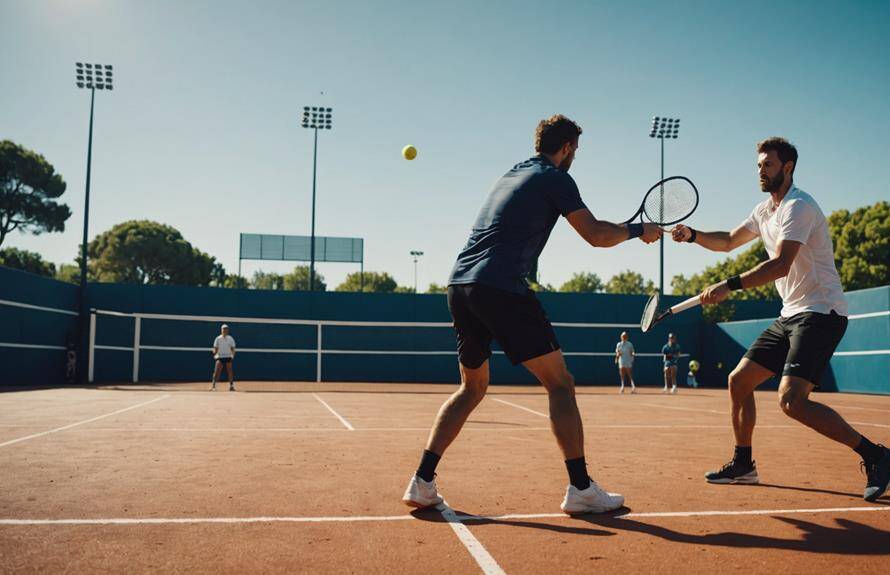Mastering the volley in padel starts with the right ready position. Hold your racket slightly away from your body and stand with your feet shoulder-width apart.
For forehand volleys, step forward with your left leg and keep your forearm strong to block the ball. Backhand volleys require a firm wrist and bending your legs for power.
Avoid common mistakes like incorrect grip or staying too close to the net. Ensure quick, precise footwork and a stable base.
Regular drills can greatly boost your reaction time and positioning. Keep honing these techniques for a solid volley game!
Key Takeaways
- Maintain a ready position with the racket held slightly away from the body for quick reactions.
- Step forward with the opposite leg to the hitting hand to enhance stability and power.
- Focus on a strong blocking motion rather than swinging the racket.
- Keep feet shoulder-width apart to maintain a stable base and balance.
- Engage in drills that emphasise quick reactions, precise footwork, and accurate positioning.
Ready Position
In the volley ready position, you'll hold your racket slightly further from your body and more vertically for quicker reactions. This setup is vital as it prepares you to respond instantly to fast and close-range balls. Positioning yourself closer to your opponents is also essential. By doing this, you minimise the distance your racket needs to travel, ensuring you meet the ball early and effectively.
Quick preparation is the cornerstone of mastering volleys. The game's pace demands you maintain a stable base and balance. Your feet should be shoulder-width apart, knees slightly bent, and your weight evenly distributed. This stance keeps you agile, allowing rapid adjustments in any direction.
Being in the proper ready position isn't just about physical stance; it's a mental readiness too. Anticipate the ball's trajectory and be prepared to react swiftly. Keep your eyes on the ball and your mind focused on the next move. This vigilance will enhance your ability to handle fast-paced exchanges at the net.
Mastering the volley ready position means you'll react more swiftly and accurately, giving you an edge over your opponents during intense net play.
Forehand Volley Technique
Mastering the forehand volley technique starts with positioning your racket slightly further from your body in a vertical stance for quicker reactions. This stance allows you to respond swiftly to incoming balls. Begin the stroke by taking the racket back and turning your shoulders. This movement generates the necessary power and control for an effective volley.
As the ball approaches, step forward with your left leg. This forward motion helps stabilise your body and positions you perfectly to block the ball in front of you. Remember, focus on a strong blocking motion instead of swinging the racket. Swinging can lead to instability and reduced accuracy.
Maintaining a stable base is essential. Keep your feet shoulder-width apart and your knees slightly bent. This stance ensures balance throughout the shot, allowing you to react efficiently to different ball speeds and trajectories. By emphasising control and stability, you'll be able to place the ball precisely where you want it on the opponent's court.
Incorporate these elements into your practice routine. With consistent effort, you'll master the forehand volley, turning it into a formidable weapon in your padel arsenal.
Backhand Volley Technique
To execute a perfect backhand volley, begin from the ready position with your racket held firmly in front of your body. Step forward with the leg opposite to your racket hand to meet the incoming ball. This essential step provides the necessary balance and alignment for a controlled shot.
Maintain a firm forearm and wrist to guarantee stability and control throughout the volley. A steady grip helps you absorb the ball's impact and direct it precisely where you want. Keep the racket head above your hand. This positioning is key for better precision and direction, allowing you to place the ball accurately on your opponent's court.
Bend primarily with your legs, not at the hips. This keeps you in a strong, balanced position, ready to react quickly to any unexpected changes in the ball's trajectory. Using your legs to lower your stance also helps maintain your centre of gravity, crucial for a powerful backhand volley.
Common Errors
One frequent mistake players make during volleys is using an incorrect grip, which can cause open shoulders and hips, leading to a loss of stability and control. When your grip isn't right, your entire body alignment suffers, making it difficult to execute precise and powerful volleys. Be sure to hold the racket with a continental grip to keep your body properly aligned and balanced.
Getting too close to the net is another common error. This positioning limits your reaction time and hampers your ability to move effectively. You may find yourself overwhelmed by fast shots, unable to adjust quickly. Instead, maintain a moderate distance from the net to give yourself the necessary space to react and execute shots with precision.
Staying back a bit more grants you additional time to adjust to incoming balls, boosting your overall performance. A solid volley requires a stable base, so focus on maintaining a balanced position. Rather than bending at the hips, bend your legs to lower your centre of gravity and stay grounded.
This leg-driven stability will enhance your control and power during volleys, allowing you to play more effectively and confidently.
Effective Volleys
For effective volleys in padel, you need a quick shift into a stable ready position. This sets the foundation for delivering controlled and powerful shots. Start by taking the racket back slightly, ready to engage.
As the ball approaches, step forward and block the ball in front of your body. This forward motion helps maintain control and power in your volley.
A strong grip and a stable base are essential. Without these, you risk common errors like hitting the ball off-centre or losing balance. Both forehand and backhand volleys demand a strong forearm and wrist. This strength allows you to manage the ball's speed and direction effectively. Keep your wrist firm to avoid any wobble that could send the ball off course.
When volleying, focus on stepping forward and meeting the ball with a solid, stable forearm. This action not only enhances your shot's precision but also helps maintain your balance throughout.
Footwork for Volleys
Mastering footwork for volleys means stepping forward with the opposite leg to your hitting hand, ensuring power and stability in your shots. When you step forward with this leg, you create a strong base that allows you to transfer your weight efficiently. This weight transfer is vital for adding both power and precision to your volleys.
Quick and precise footwork is essential. You need to be nimble and decisive to reach the ball in time. By stepping forward correctly, you'll position yourself for excellent balance. This stability not only boosts your power but also your control over the shot. Without this solid base, your volleys can become erratic and less effective.
Maintaining a stable base with the correct footwork enhances your overall volleying technique. A consistent, well-balanced stance allows you to react swiftly to your opponent's shots. You'll find that your volleys become more accurate and reliable.
Drills and Practice Tips
Incorporating specific drills into your practice routine can greatly enhance your volley skills. Focus on volley drills that sharpen your quick reactions and positioning. For instance, practise volleying against varied shots like lobs and low balls. This will make you more adaptable and ready for any situation during a match.
Footwork is essential. Engage in drills that emphasise efficient movement to reach volley shots in time. Quick lateral movements and sudden stops should become second nature. Also, target practice drills can work wonders for your accuracy. Set up targets on the court and aim to hit them consistently. This will improve your precision and placement, making your volleys more effective.
Don't overlook the value of feedback. Have a coach or an experienced player observe your drills. They can point out areas needing improvement, enabling you to tailor your practice sessions more effectively.
Consistent, focused practice combined with constructive feedback will elevate your volley game to new heights. Remember, mastery comes from dedication to refining your skills. Keep pushing your limits, and you'll see substantial improvements in your volleys.
Conclusion
Mastering the volley in padel can greatly elevate your game. Remember, maintaining a ready position and perfecting both forehand and backhand techniques are key.
Avoid common errors by focusing on effective volleys and proper footwork. Consistent practice with targeted drills will hone your skills and boost your confidence on the court.
So, keep practising, stay agile, and you'll see notable improvements in your volley game. You've got this!




